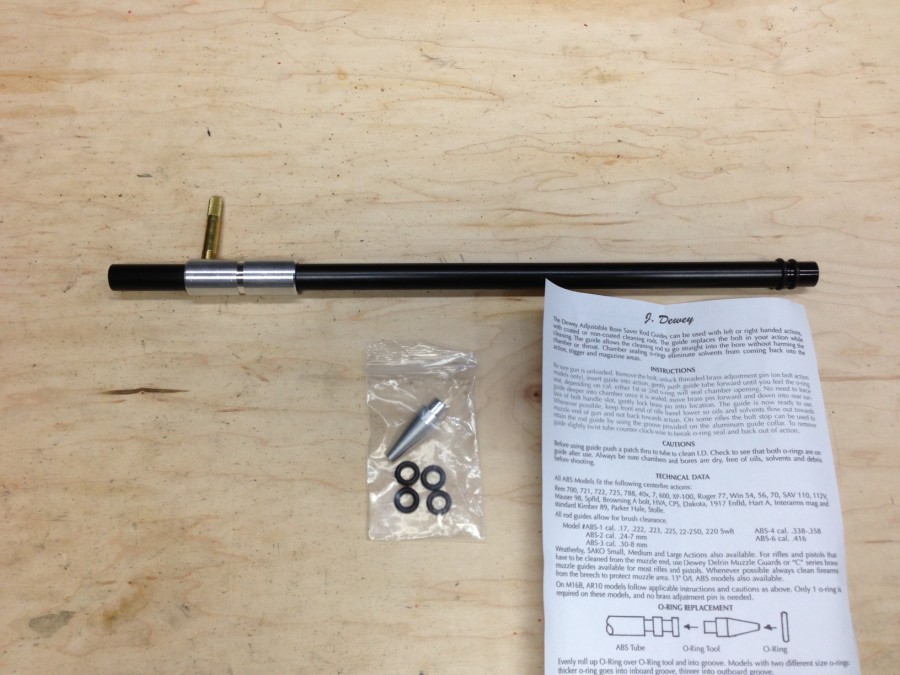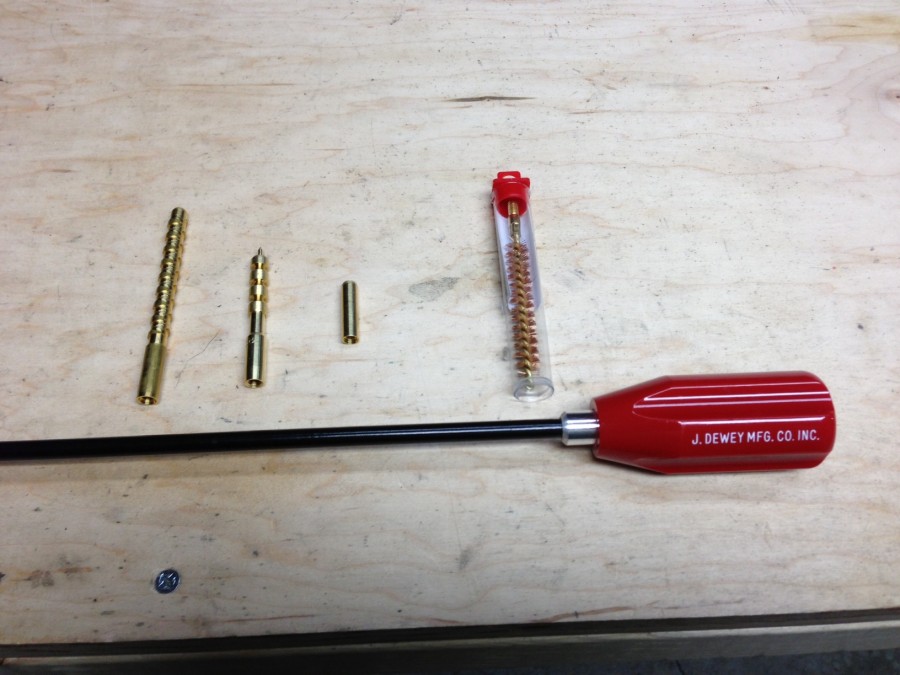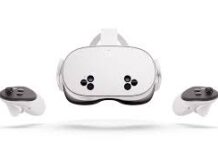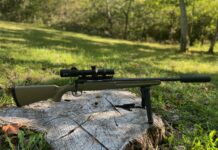Once in a while the powers that be here at TTAG decide to throw me a bone and let me review something that I didn’t buy with my own cash. In this case, the folks over at J. Dewey Manufacturing were pretty excited about their new Bore Saver Rod Guide in .338 Lapua Magnum. Fortunately, Tyler remembered my review of the Savage 111 Long Range Hunter in .338 Lapua and pointed Dan in my direction. Since my existing cleaning equipment had a rather glaring shortcoming (more on that in a bit) where it came to my .338 Lapua, I was only too happy to check it out . . .
A bore guide is one of those tremendously useful things that you find you can’t live without once you get your first one. While bore guides are available for the AR15 platform, they really come into their own when you pick up your first bolt action rifle.
When you clean your gun, the ideal is to make sure that the solvents and other cleaning/lubrication solutions go where you want them (your barrel) and stay out of those areas you don’t (your fire control group, aka trigger). With a pistol or an AR, it’s pretty easy to separate the components of the gun so that you can concentrate the cleaners where they need to be. Bolt action rifles, however, present a slightly different problem.
Basically, the way you clean them is to remove the bolt, then slide the cleaning rod in from the rear of the action all the way through to the muzzle. The issue is that when you push a cleaning patch or brush saturated with cleaning solution from the rear of the action, that sodden patch crosses over the fire control group on its way to the breech face. Good luck ensuring none of that drips where you don’t want it.
A bore guide is the answer to this problem. The bore guide slides into the action just like the bolt would and mates with the breech, providing a perfectly straight channel for the cleaning rod to travel. This virtually eliminates any chance of damaging the breech face with a cleaning tool.
Once the bore guide is inserted into the barrel, all you need to do is fix your selected cleaning implement to the tip of a cleaning rod and run it through the guide into the barrel. The Dewey bore guide has a small port at the back end that lets you apply the solvent or your choice or cleaning solution to the patch once its in the guide. This saves you from having to first apply the solvent to the patch and then wrap the soggy patch around the cleaning rod. A nice feature that keep things neat and tidy.
In truth, the J. Dewey guide wasn’t my first bore guide. I have one from another manufacturer that I’ve used for some of my other rifles. While it technically works in my .338, it’s less than ideal.
The other guide comes with three different tips to handle calibers ranging from .17 to .460. The problem is that “universal” is a code word meaning “does lots of things okay, but none of them particularly well.” To be “universal”, three different tips are included that enable it to span multiple calibers, but it lacks the precision that a caliber-specific guide gives you.
And that’s where the Dewey Bore Saver rod guide shines. First of all, the bore guide is designed for one specific caliber — in my case, .338 Lapua. It fits the chamber perfectly so the cleaning rod enters dead center. What makes the Dewey part even better, though, is the pair of O rings that provide a water-tight seal at the end so that even if there is some excess cleaning solution that builds up at the breech, it can’t flow back into the action of the rifle.
When you order a .338 bore guide from J. Dewey, you need to specify if you need a standard .338 or a .338 Lapua Magnum. The Magnum is slightly larger in a couple dimensions than standard .338 calibers such as the .338 Remington Ultra Magnum or the .338 Norma Magnum. Specifying the right Lapua flavor ensures that you get the right sized O rings. To the best of my knowledge, J. Dewey is the only company currently offering a bore guide specifically for .338 Lapua Magnum.
Now, let’s be honest with ourselves here. At $26 for a Dewey bore guide, you’re going to pay more than you would for some of the “value” brands. And you’ll get a bore guide that only fits the .338 Lapua. So, in terms of value for your buck, you might be tempted to wonder why you should pay more to get less functionality.
If you’re thinking that (and I know some of you probably are), I want you to do something for me. Stand up (don’t worry, I’ll wait) and choose a good solid wall. Now, stand about 10 feet back and with a good running start, slam your head face-first into it. Okay, you back? Good. You deserved that.
A .338 Lapua rifle isn’t a cheap toy. My Savage was about $1,000, but this is pretty much the bargain basement price to get into the caliber. Most .338 rifles will run you 2-3 times that or more. If you’ve laid out the money for the rifle, you need to get serious about treating it properly and a good bore guide like the Dewey is what you need to treat your rifle right.
J. Dewey actually offers two versions of the bore guide in .338 – one for scoped rifles and one for rifles without scopes, strangely enough. The difference in price is all of $1 and the scoped version buys you an extra 3 inches of length, which helps of you have a scope that sticks far enough out from the back of the action that it would get in the way of the cleaning rod.
Now, if you are capable of precision shooting the .338 Lapua Magnum at its effective range without a scope, there are a number of elite military units that would probably like to talk to you. The fact is that most, if not all .338 Lapua Magnum rifles are going to have a scope. Whether you need the longer bore guide is going to depend on where the scope sits on your rifle. On the one hand, you won’t go wrong with the longer bore guide if you want to be safe. You’ll just need to consider whether your cleaning rod is going to be long enough to make it all the way through the barrel with the extra length of the bore guide.
Along with the guide, J. Dewey was kind enough to send a selection of their cleaning tools for the .338 Lapua Magnum.
These consisted of a J. Dewey 44 inch nylon coated cleaning rod, Two jags, one a standard .338 pointed jag and the other, a .338 Parker Hale Style jag. I also had a brass core .338 bronze bristle brush along with an adapter to make it fit the threads of the cleaning rod.
One of the mistakes I made with an earlier cleaning rod was to get one that was too short. A 36-inch rod may be fine for smaller calibers and some types of rifles, but if you’re going to use a bore guide, you need to add the length of the chamber plus the distance the bore guide protrudes from the back of the chamber to your barrel length to get the total length needed for a cleaning rod to traverse. Fail to do this and you get a situation like this:
 Don’t see any problems? Well, let me tell you . . . that its a class A PITA when your cleaning rod is a bit too short and your patch gets caught in the muzzle brake. Or even worse, you have to try and reverse the direction of your bore brush before it has completely cleared the barrel. The right length cleaning rod should completely exit the barrel and any muzzle brake like so:
Don’t see any problems? Well, let me tell you . . . that its a class A PITA when your cleaning rod is a bit too short and your patch gets caught in the muzzle brake. Or even worse, you have to try and reverse the direction of your bore brush before it has completely cleared the barrel. The right length cleaning rod should completely exit the barrel and any muzzle brake like so:
The point here is that if you plan to use a bore guide, you need to plan for the extra real estate when ordering your cleaning rod.
So, how did I like the overall J. Dewey experience? I’ve already summarized my thoughts on the Bore Saver Rod Guide. As for the cleaning tools, they’re top notch, too. The jags are brass which reduces the chances of you damaging the rifling of the barrel when you’re cleaning. J. Dewey offers two kinds of jags in lots of calibers so no matter which version you’re comfortable with, you’ll find something to suit you.
The bore brush has a brass core, as opposed to the steel you tend to find on cheaper bore brushes. Keep in mind that steel can damage the rifling, so its best to stick with brass whenever possible. Finally, the cleaning rod is nice and stiff and the handle rotates smoothly to keep the brush or jag rotating easily as it moves down the barrel. I’m very happy with what I’ve seen and can now finally clean my .338 Lapua Magnum rifle the way it deserves.
Prices:
- Bore Saver Rod Guide for .338 Lapua Magnum: $24.95
- 338 Brass Core Bronze Bristle Brush: $2.25 $2.25
- .338 Brass Jag: $3.95
- .338 Brass Parker Hale Jag: $6.95
- .30 Nylon Coated Cleaning Rod 44″: $29.95
Ratings (out of five stars):
Design: * * * * *
The bore saver is specifically designed to fit the .338 Lapua Magnum and the inclusion of the O-rings keeps all the nasty stuff out of the action. It’s not a one-size-fits-all approach, but it fits my gun perfectly.
Construction * * * * *
Good, solid materials make for sturdy tools. Dewey doesn’t use cheap steel or other metals that could damage your rifle barrel – only the best here.
Value * * * *
The bore guide is worth the price for the protection it provides your expensive rifle. Some of the cleaning tools are available in packaged kits, but many of the items need to be purchased either a la carte or as add-ons to an existing kit. I’d like to see a bit more packaging such as being able to purchase a set of jags or brushes in different calibers rather than having to order each one individually. This, though, is a minor nit to pick.
Overall * * * * 1/2
The J. Dewey line of products are well made and clearly have been designed by gun people for gun people. You can buy cheaper stuff, but you’re not going to find better. For those who want to really take care of their firearms, J. Dewey is the place to go. All they make are cleaning tools and they do them well. Now I just hope that their marketing guy forgets to ask for this stuff back.










I was just looking at the J Dewey stuff for my AR. Glad to hear they make such good gear.
Pull the trigger on J Dewey…it’s worth the money.
When I got my Remington 700 in .243 a few months ago, I looked hard at these, but ended up not buying them, because I didn’t think they were necessary. I just picked up a bore snake and I’ve been using that. Your review made me decide to go ahead and pick up a set for my rifle. After all, I want it to last as long as I do, and that means taking proper care of it.
Looks like the next purchase I’ve got to make to clean my .338 Savage 110 BA. Which I haven’t shot yet – because it doesn’t have a scope. Something tells me that looking down a rail will be less accurate than the Bushnell 6500 I’ll eventually purchase.
Bravo! Well done, Jim. I wish I had time to have written up something like this, as I consider bore guides and proper cleaning rods to be some of the most important investments an accuracy-minded rifleman can make to preserve the accuracy of his rifle.
Two other points on bolt gun cleaning:
1. Clear breech to muzzle, as Jim has shown here. Do not go hog wild with the brush. There are more good barrels ruined with absurd over-use of a brush than people would think. Do not use steel brushes (except on some shotgun situations). Do not use brushes that have steel cores (ie, the center where the bristles are mounted).
Modern copper and lead solvents remove much of the need for vigorous brushing. Following the instructions on the product labels (ie, applying and waiting for the solvents to work), followed by judicious application of brushing has replaced the “scrubbing” of years past to remove copper/lead fouling from bores.
When you’re cleaning from breech to muzzle with a brush, never drag the brush back into the bore from the muzzle after the brush has exited. The brush picks up debris from the bore and you don’t want to drag that crap over your crown. Your job, as a rifle owner, is to protect the crown of your barrel. Barrels can be re-crowned by a gunsmith and doing so isn’t a huge expense, but this is something you can avoid with proper care.
Likewise, patches are pushed from the breech to the muzzle. Do not pull a filthy patch back into the bore over the crown. You just got that crap out of your bore. Why would you want to pull it back in?
Never, ever, ever reverse a brush in the bore. As Jim has clearly demonstrated, get a rod that is long enough for the job and check it for full exit length before you put a brush on it.
2. The other reason for a bore guide that Jim didn’t spill here is that you don’t want your rod riding on the important surfaces at the throat of your chamber. This can happen when you don’t have a bore guide, and you just cram a rod with a tight patch down the barrel. What happens to small diameter, long pieces of metal or composite when you push on them? They bend outwards away from their central axis – ie, they bow. When you’re pushing on a rod that’s bowing, it will have to be limited by something in the bore, and one surface that might catch the rod will be the front end of the chamber, right in front of where the neck of the case ends in the chamber. That’s your “throat” in your chamber, and the erosion of your chamber throat is the reason why barrels “shoot out” after several thousand rounds. Don’t accelerate the erosion of the throat by running a bore rod that’s bowing over it. It will harm your throat and, if your rod is coated like the one above, it might damage the coating on the rod.
Using a proper fitting bore guide is how you keep the rod properly aligned and not bowing in the action area, where it has room to bend, before you get to the constrictions at the front of the chamber.
Last point: When you’re done with a cleaning rod (or even in between passes), wipe it down with a good quality shop towel. Get the grit and crap off it. Inspect it for nicks, abrasions and such. Coated rods vs. bare stainless rods is a big point of discussion in some circles. Benchrest shooters need something to obsess about (or else they’re not happy), and some benchrest guys obsess about coated vs. bare rods. For the rest of us: Just clean the rod with a good shop towel, maybe some bore solvent followed by something like WD-40, and get any grit or metal particles off of it.
I have a bunch of J. Dewey rods, as well as several makes of rods (in shotguns, there’s lots of names TTAG folks have never heard of). I’ve never had cause to complain or be unhappy about any J. Dewey product I’ve owned.
Very well, J Dewey it is for the .338.
Thanks for the assist, DG! Always learn something new from your posts.
Comments are closed.